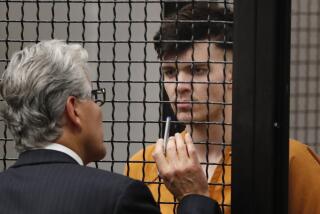Jury Refuses to Exonerate Sam Sheppard in ’54 Killing
- Share via
CHICAGO — Forty-six years after Dr. Sam Sheppard was convicted of murdering his pregnant wife in a trial that riveted the nation, 34 years after he was acquitted in a second trial and 30 years after the once-rakish osteopath died a broken man, a civil jury hearing a wrongful imprisonment suit on Wednesday declined to clear him of the crime.
The couple’s only child, Sam Reese Sheppard, who filed the suit following years spent trying to clear his father’s long-sullied name, wrung his hands and smiled a sad smile as the verdict was read in a Cleveland courtroom.
“The Sheppard family was bloodied,” the 52-year-old said after the verdict, “but not bowed.”
The younger Sheppard, who grew up watching as the story of his family spawned “The Fugitive” TV series, the 1993 film of the same name and countless books and stories, also stood to receive about $2 million for the 10 years the elder Sheppard spent in prison had he won, though Sam Reese Sheppard has said repeatedly that the case was never about the money.
Because this was a civil rather than criminal trial, the burden of proving Sheppard’s innocence fell to the son and his attorney, Terry Gilbert, who had to demonstrate by a preponderance of the evidence that Sheppard did not murder his wife. Before sending the eight panelists off to deliberate Wednesday morning, Judge Ronald Suter of the Cuyahoga County Court of Common Pleas told them that, to find for the son, they must decide Sheppard was in fact innocent of the crime--a higher standard than “not guilty” in a criminal trial.
After 2 1/2 months of testimony, however, the jury took just three hours to dismiss the younger Sheppard’s claim that his mother was bludgeoned to death not by his father but by an intruder, perhaps the family’s troubled window washer.
Despite the exhumation of Marilyn Sheppard, new blood evidence, new DNA evidence and a new potential suspect in the form of the window washer, however, this trial seems no more likely to change strongly held opinions than the previous two.
“Juries have found against Dr. Sam Sheppard, they have acquitted Dr. Sam Sheppard and now they have said that his lawyers have not proven that he’s innocent,” said James Neff, author of a forthcoming book on the case called “Chasing the Fugitive.” “The show will go on.”
The young Sheppard and his attorney sought to offer jurors two reasons to doubt Sheppard’s guilt. First, they painted the original investigation as not only sloppy but slanted, suggesting that officers decided within hours that Sheppard had murdered his wife.
Second, they brought in the story of Richard Eberling. The family’s window washer, Eberling died in 1998 while in prison for an unrelated 1984 murder. He became the focus of the younger Sheppard’s suspicions several years ago, and a central figure in the 1997 book “Mockery of Justice,” which Sam Reese Sheppard penned with New York writer Cynthia L. Cooper.
At one time, Sheppard and Gilbert hoped DNA evidence might tie Eberling directly to the crime. But as the trial played out, it became clear there would be no startling revelations.
DNA tests on blood from the crime scene and on vaginal swabs found DNA with genetic components similar to Eberling’s DNA, but nothing that could name him as the only possible source of the blood.
The prosecution, meanwhile, built its case out of the previous ones, having hours of decades-old testimony read into the record. Prosecutor William Mason repeatedly referred to Sheppard as “the playboy of the western world,” and prosecutors portrayed “Dr. Sam,” as he was known, as a philanderer trapped in an unhappy marriage who was particularly upset that his wife had recently become pregnant again.
The Sheppard saga began early on the morning of Independence Day, 1954, when police arrived at the Dutch Colonial home in the suburb of Bay Village to find 31-year-old Marilyn Sheppard in a blood-soaked bed.
Sam Sheppard, a dashing 30-year-old with a taste for water-skiing and, the country would soon learn, other women, told officers he had fallen asleep the previous night while watching TV on a downstairs sofa. He was awakened by his wife, who was four months’ pregnant, screaming his name.
He sprinted up the stairs, Sheppard told police that day, running smack into a “bushy-haired” intruder, who struck him, knocking him unconscious. When he came to, the intruder was still in the house, Sheppard said, and he pursued him, through the yard, down to the shore of Lake Erie, where the intruder knocked him out once again. When he regained consciousness, Sheppard said, he called his neighbor, the mayor, who placed the first call to police.
The outpouring of public sympathy for the young doctor lasted just a few days, and even less for investigators, who thought Sheppard’s story improbable and wanted to know what happened to the shirt Sheppard had been wearing the night before. It was never found.
By the time word spread of extramarital affairs--Sam denying and then admitting to two, Marilyn rumored to have her own lover, perhaps the mayor--local newspapers were screaming for the doctor to be arrested.
In a 1966 landmark decision, the Supreme Court ruled that the flood of pretrial publicity in 1954 had prevented the doctor from receiving a fair trial.
He went on trial again, with F. Lee Bailey as his counsel. Sheppard was acquitted, and freed.
*
Times researcher John Beckham contributed to this story.
More to Read
Sign up for Essential California
The most important California stories and recommendations in your inbox every morning.
You may occasionally receive promotional content from the Los Angeles Times.













